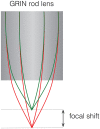Circuit Investigations With Open-Source Miniaturized Microscopes: Past, Present and Future
- PMID: 31024265
- PMCID: PMC6461004
- DOI: 10.3389/fncel.2019.00141
Circuit Investigations With Open-Source Miniaturized Microscopes: Past, Present and Future
Abstract
The ability to simultaneously image the spatiotemporal activity signatures from many neurons during unrestrained vertebrate behaviors has become possible through the development of miniaturized fluorescence microscopes, or miniscopes, sufficiently light to be carried by small animals such as bats, birds and rodents. Miniscopes have permitted the study of circuits underlying song vocalization, action sequencing, head-direction tuning, spatial memory encoding and sleep to name a few. The foundation for these microscopes has been laid over the last two decades through academic research with some of this work resulting in commercialization. More recently, open-source initiatives have led to an even broader adoption of miniscopes in the neuroscience community. Open-source designs allow for rapid modification and extension of their function, which has resulted in a new generation of miniscopes that now permit wire-free or wireless recording, concurrent electrophysiology and imaging, two-color fluorescence detection, simultaneous optical actuation and read-out as well as wide-field and volumetric light-field imaging. These novel miniscopes will further expand the toolset of those seeking affordable methods to probe neural circuit function during naturalistic behaviors. Here, we will discuss the early development, present use and future potential of miniscopes.
Keywords: 3D printing; behavior; freely moving animals; miniaturization; miniscope; open-source; systems neurobiology.
Figures





References
-
- Antipa N., Kuo G., Heckel R., Mildenhall B., Bostan E., Ng R., et al. (2017). DiffuserCam: lensless single-exposure 3D imaging. arXiv [Preprint] 1710.02134 [cs.CV]. Available online at: http://arxiv.org/abs/1710.02134
Publication types
LinkOut - more resources
Full Text Sources
Miscellaneous

